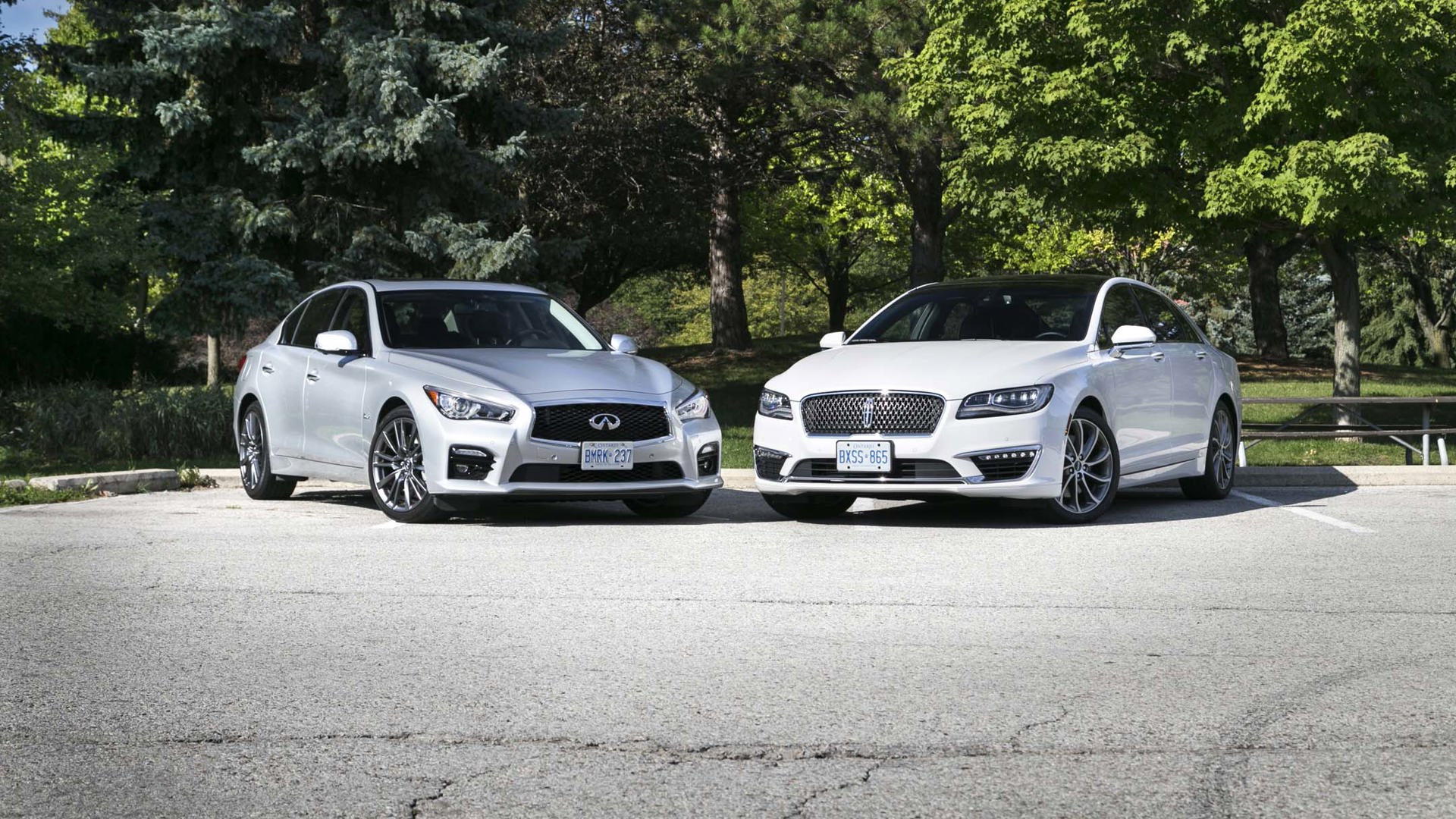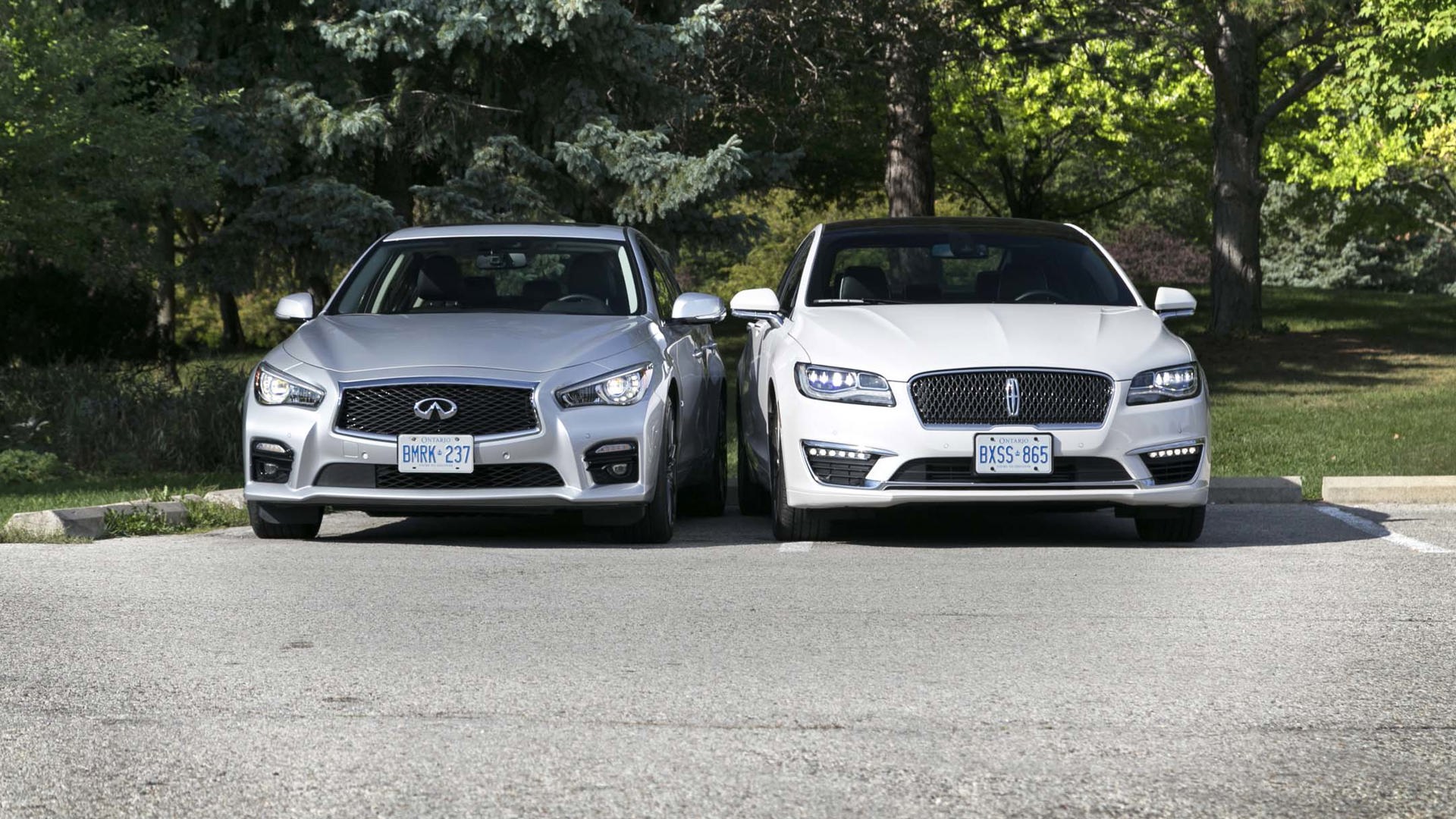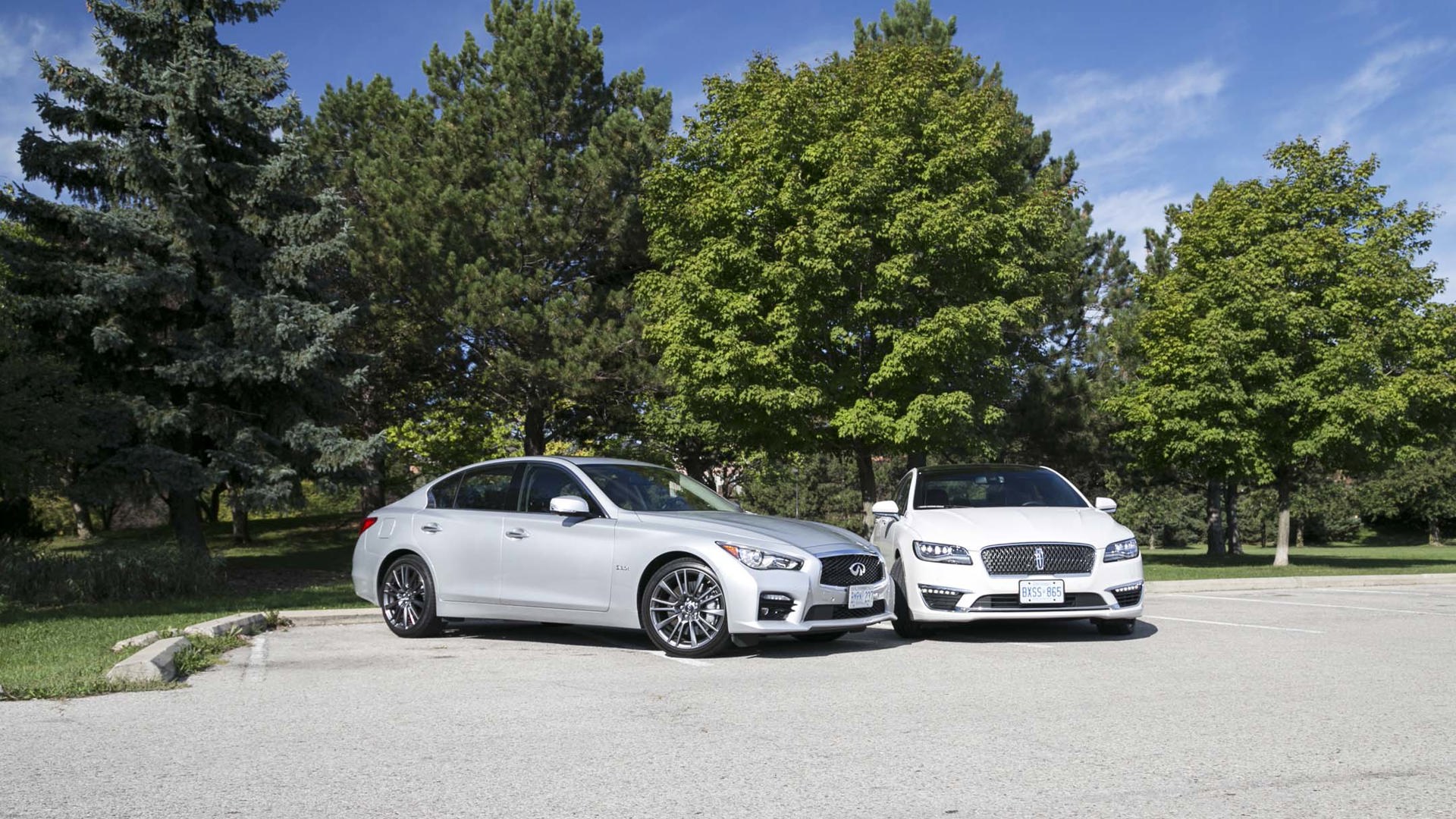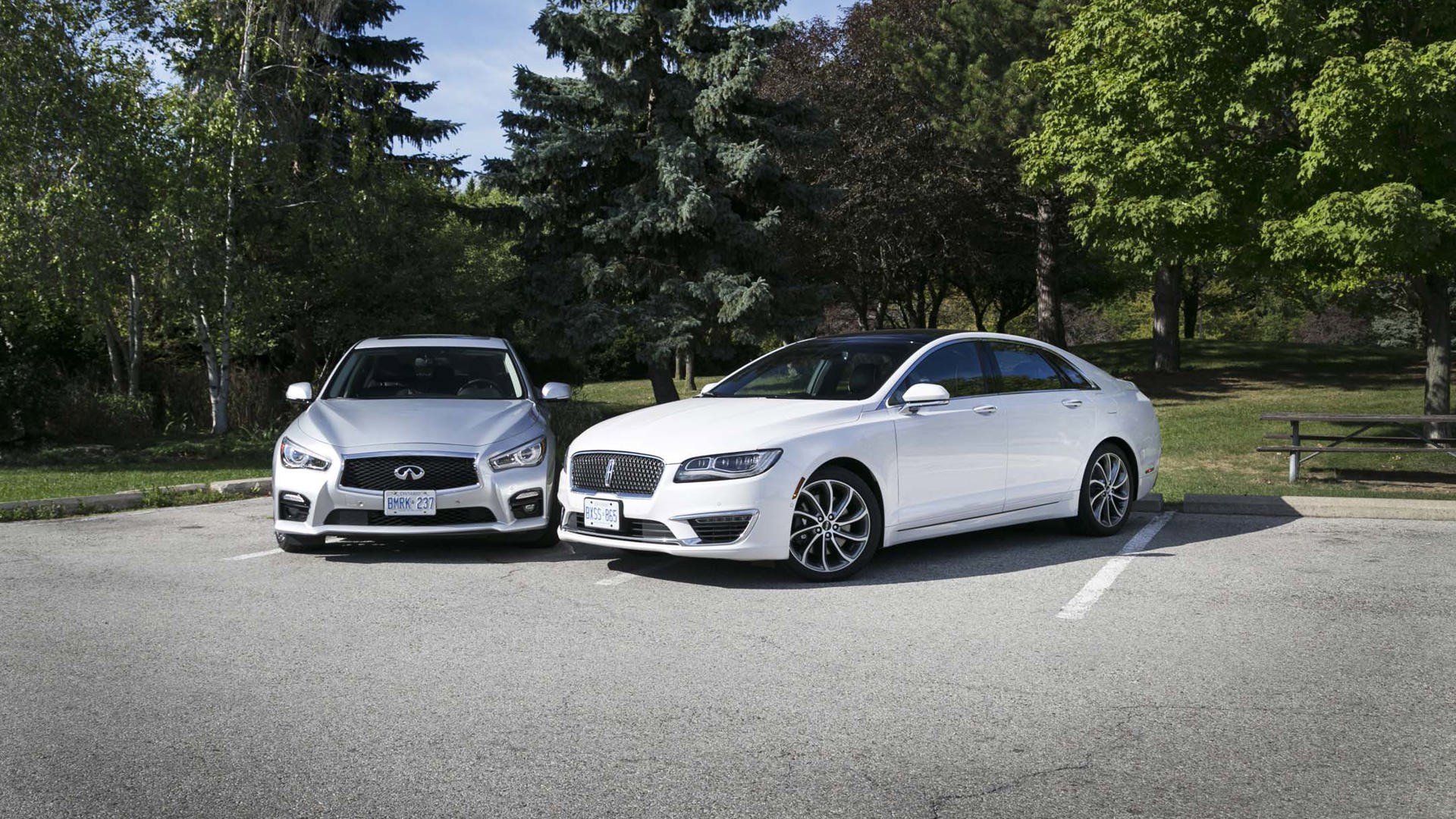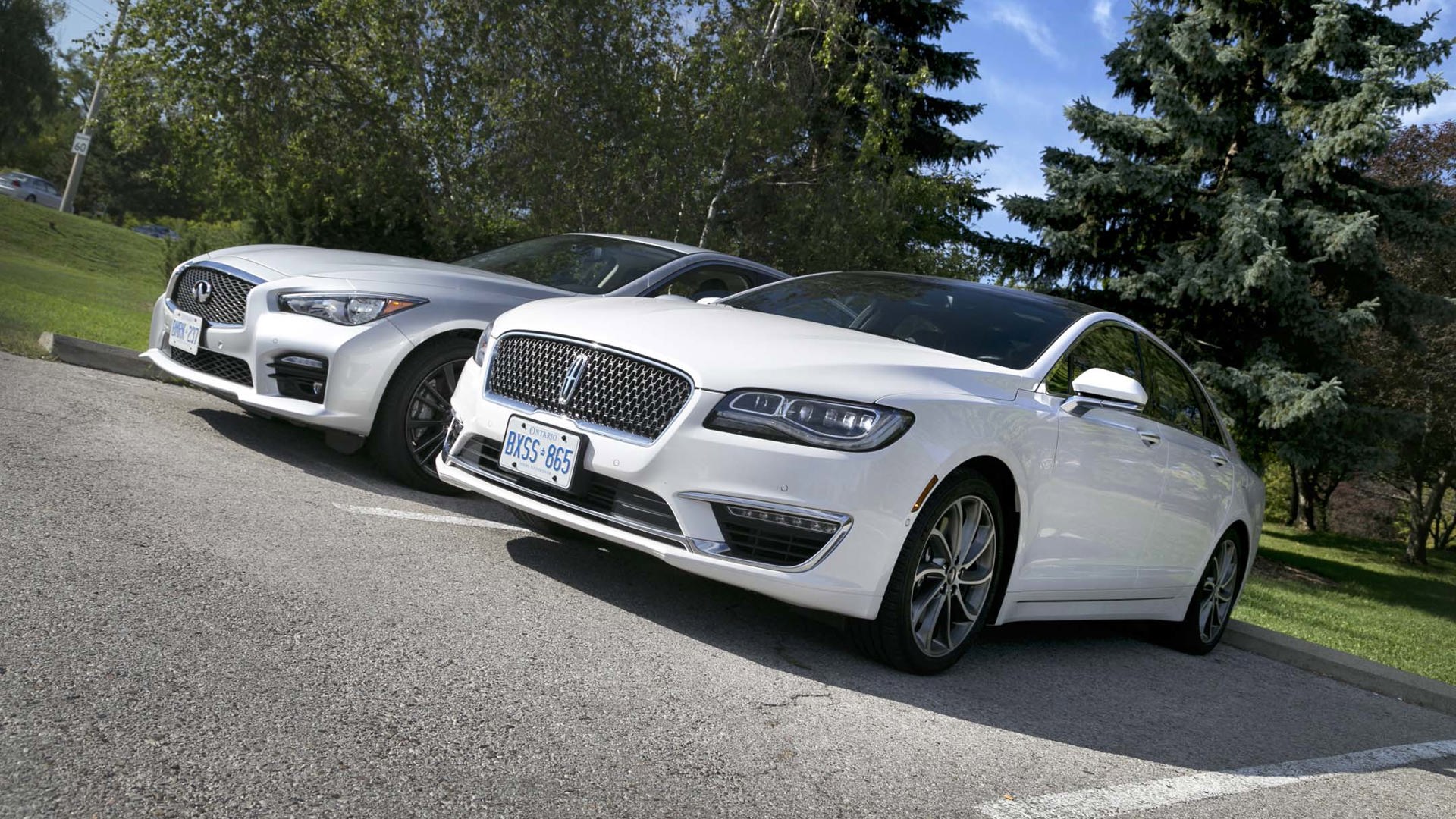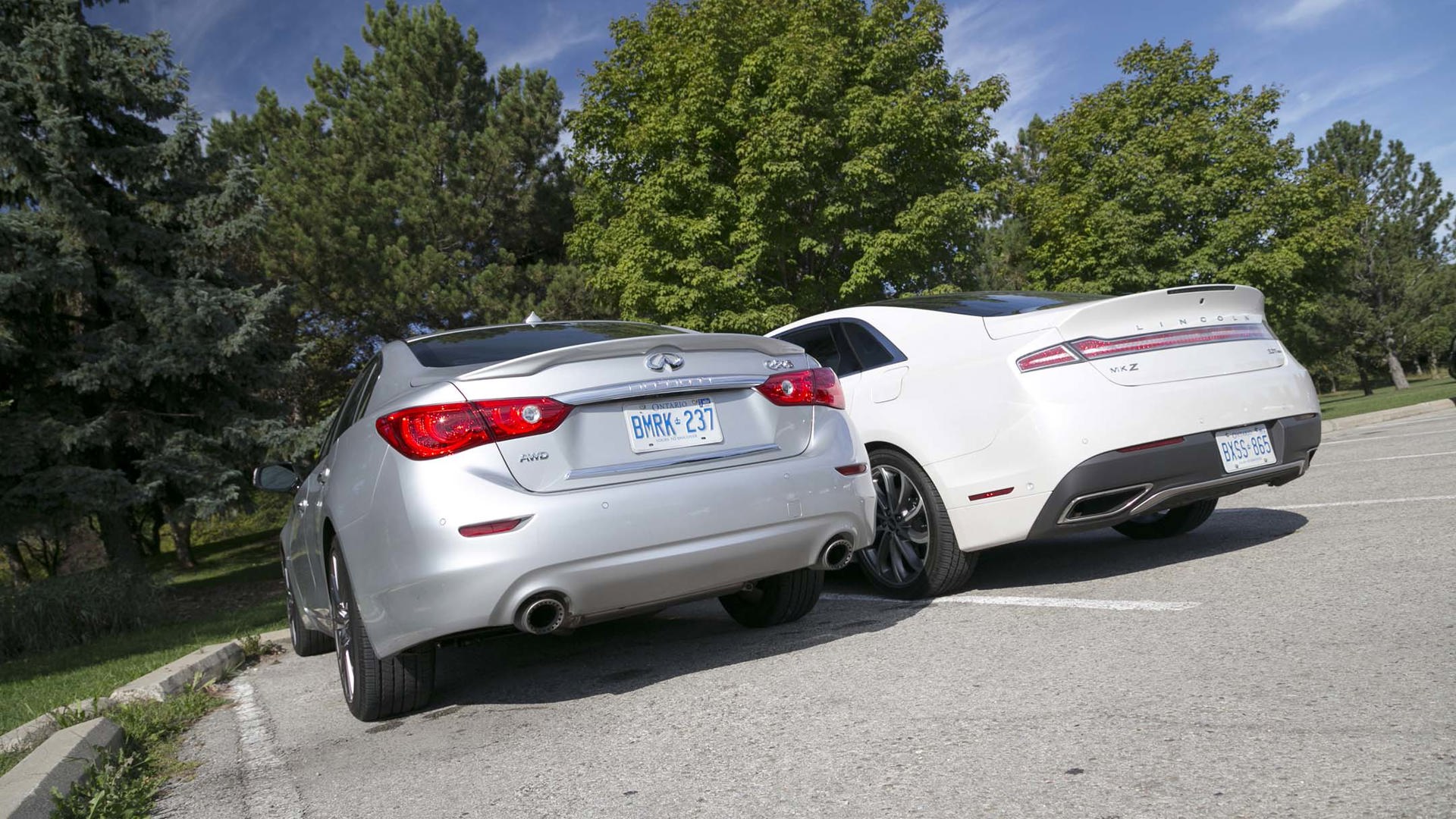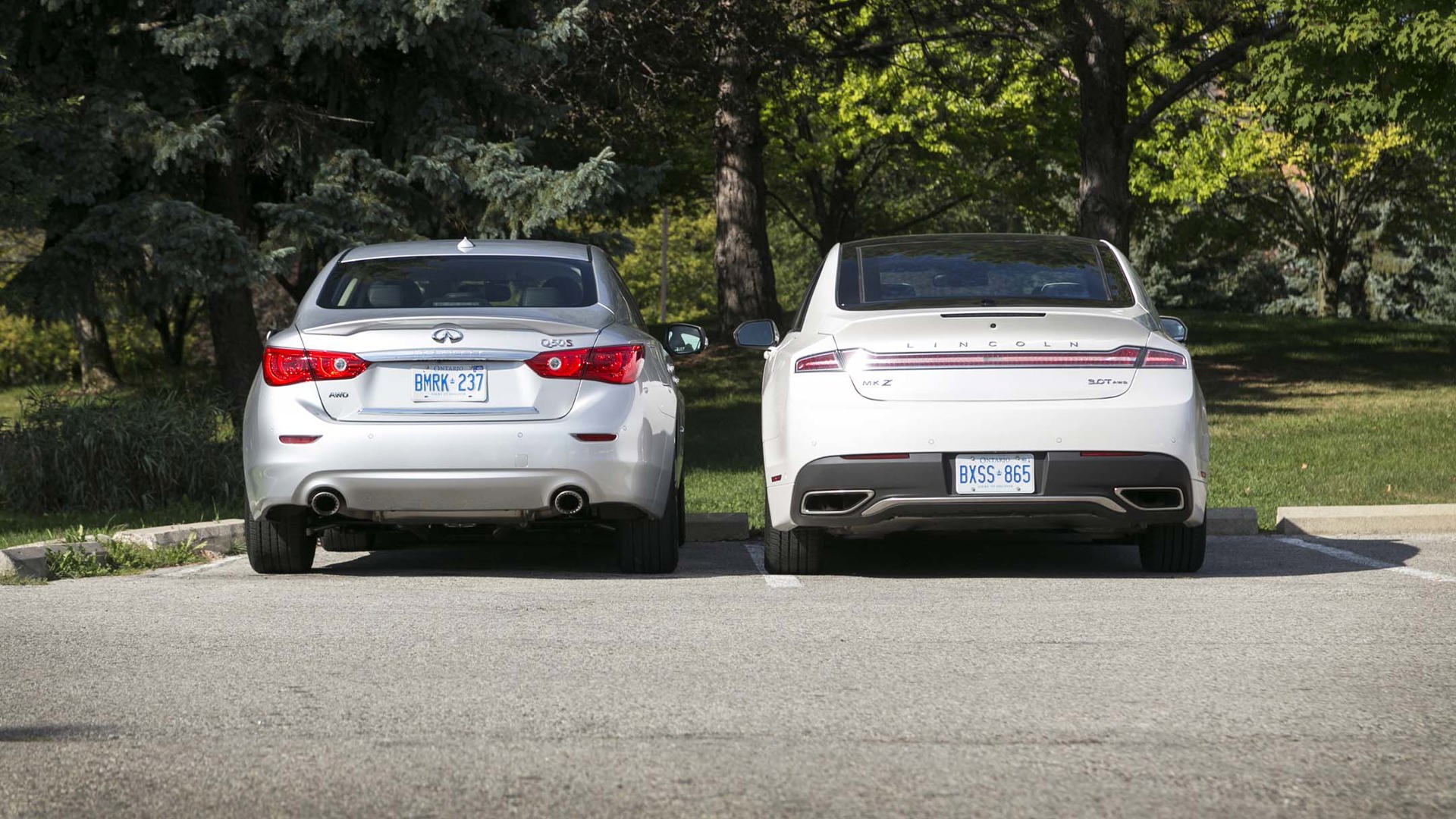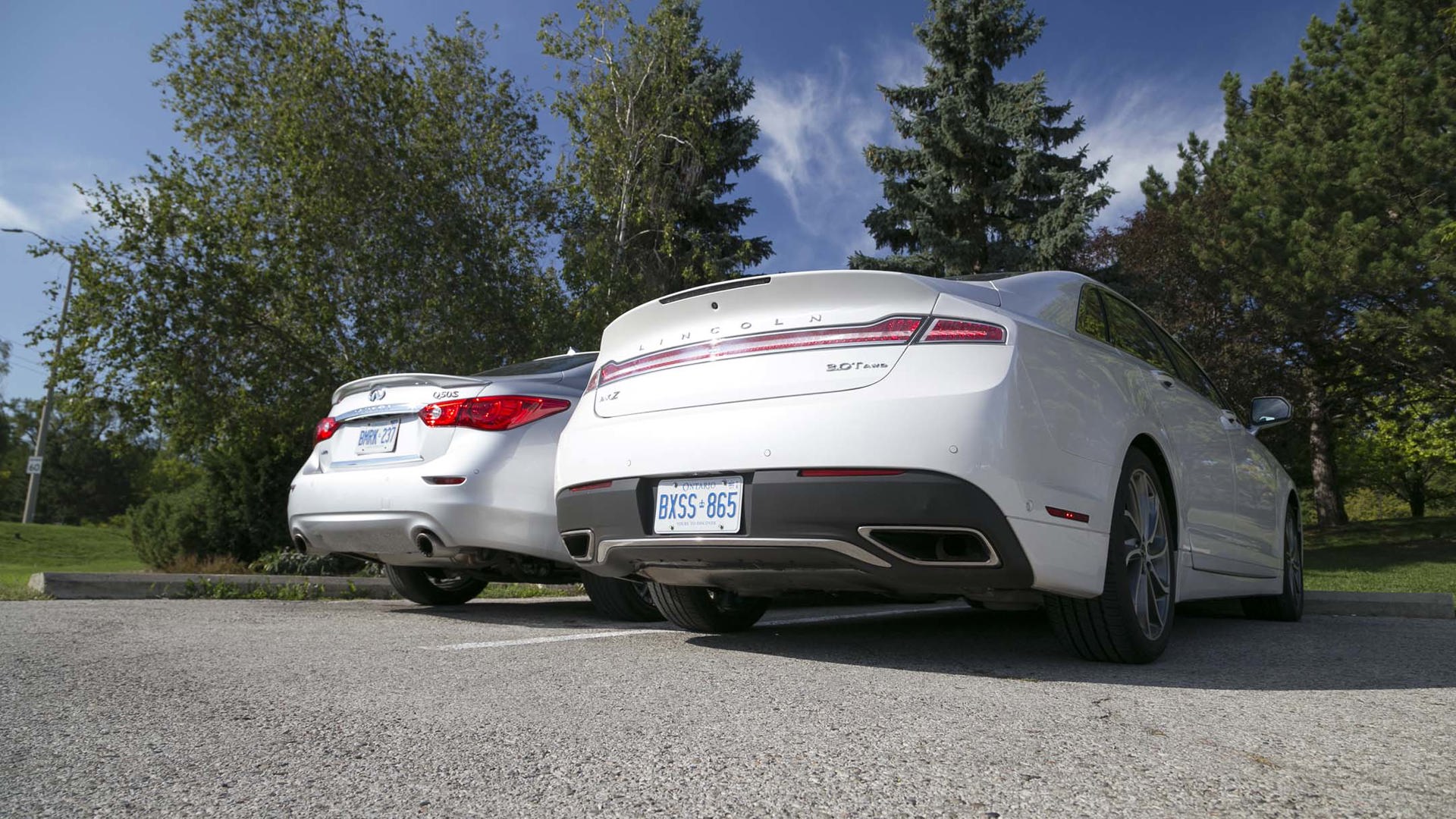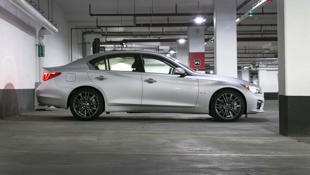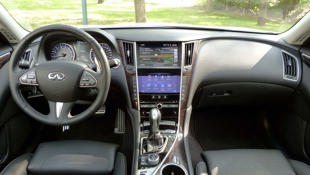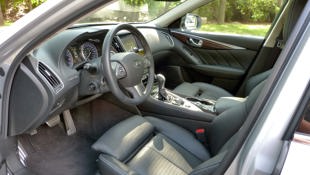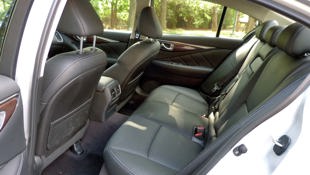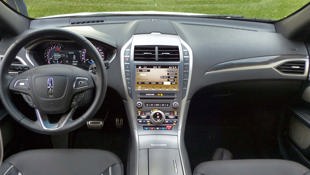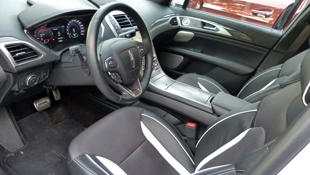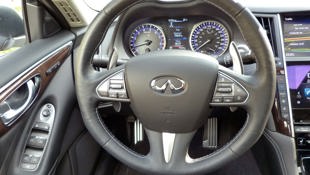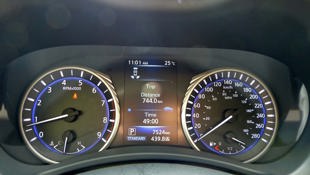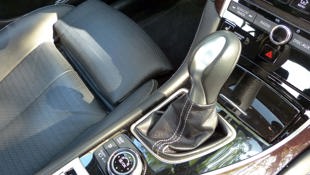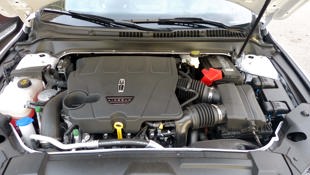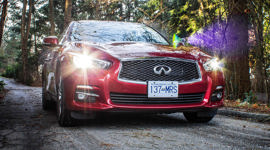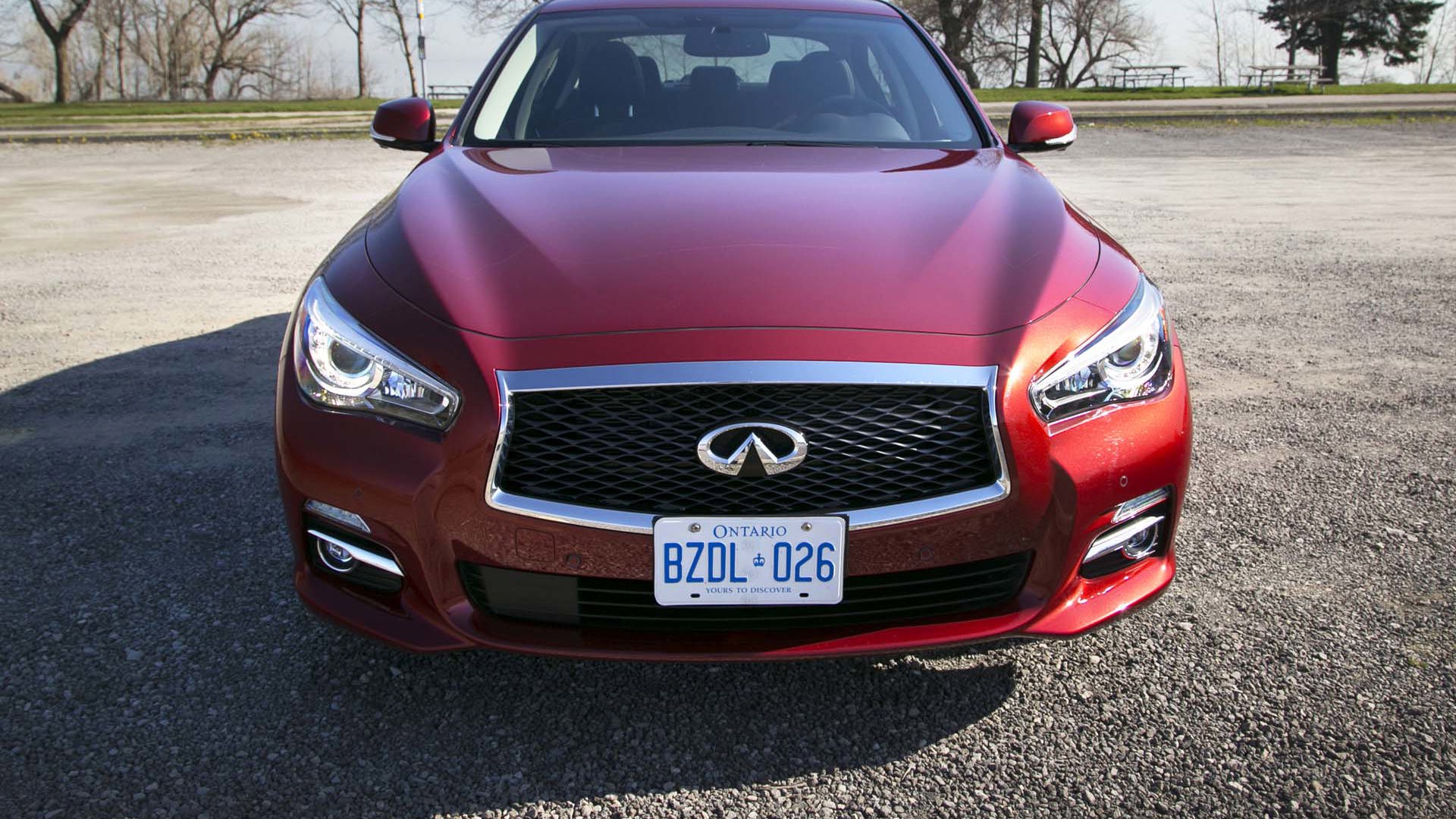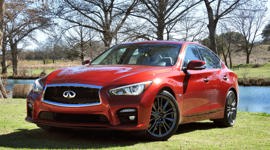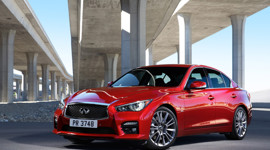Comparison Data
|
2016 Infiniti Q50 Red Sport 400 AWD
|
2017 Lincoln MKZ Reserve AWD
|
|---|---|
|
Engine Displacement
3.0L
|
3.0L
|
|
Engine Cylinders
V6
|
V6
|
|
Peak Horsepower
400 hp
|
400 hp
|
|
Peak Torque
350 lb-ft
|
400 lb-ft
|
|
Fuel Economy
10.9 L/100 km cmb
|
10.2 L/100 km cmb
|
|
Cargo Space
382 L
|
436 L
|
|
Base Price
$54,600
|
$46,000
|
|
A/C Tax
$100
|
$100
|
|
Destination Fee
$1,995
|
$1,900
|
|
Price as Tested
$60,780
|
$68,000
|
|
Optional Equipment
$4,085 – Technology Package $3,800; Metallic Paint $285
|
$20,000 – Platinum White Tri-coat Paint $700; 3.0L GTDI V6 Engine $4,500; Panoramic Roof $3,450; Technology Package $2,450; Luxury Package $5,500; Driver Sport Package $3,400
|
Not long ago, 300 was a big number when referring to the measure of a car’s horsepower. It’s a solid figure that sounds pretty impressive when describing the merits of one’s new ride at the country club or in the locker room.
400 is becoming the new 300
The trouble is we, the car-buying public, are a power-hungry bunch, whose appetite for more never seems to be satisfied. So now 400 is becoming the new 300 and if your entry-level luxury sedan doesn’t have that many ponies, well sir (or ma’am) you’re just down on bragging rights aren’t you?
Leading the charge of mid-sized 400 horsepower sedans are two unlikely sources: Infiniti and Lincoln. While the Japanese maker has been building a normally aspirated version of the sporty Q50 for a few years now (and before that the G35 / G37 sedans), this year they’ve bolted a pair of turbos to a new 3.0L V6 engine and made a lot of promotional noise about this beastly sedan offering: the 2016 Infiniti Q50 Red Sport 400.
Lincoln, on the other hand, has not traditionally been affiliated with a sporting crowd, and despite the formidable output, they’re not exactly looking to join the gang now either. Using words like “refined” and “approachable luxury” to describe the freshly updated 2017 Lincoln MKZ, it’s clear they’re not looking to paint the same power-sliding image that Infiniti’s marketers subscribe to.
Despite their differing sporting pretenses, there are a surprising number of similarities between these two that warrants a comparative look, so that’s just what we’ve done here.
The Style
Both the Lincoln and the Infiniti are downright handsome sedans. The Q50 has some familiarity now, but its proportions are right on and from any angle, it’s a harmonious blend of understated aggression and sophisticated class. If there’s a complaint to be levelled against the Infiniti, it’s that perhaps it’s a little too restrained, making it almost blend into traffic, with little aside from the badging and trademark C-pillar kink to identify it from the throngs of other mid-size Japanese sedans.
The MKZ has undergone a rhinoplasty for 2017 and wears a proud new nose that looks like it was lifted directly off a Jaguar XJ. As with the Ford Fusion (on which platform the MKZ is built, and whose front-end design appears cribbed from Aston Martin) it’s a derivative design that’s been pillaged from some of the prettiest snouts in automobiledom. The MKZ’s rear end is familiar, with the full-width taillight treatment at least standing out in traffic as uniquely Lincoln.
To my eye, the Lincoln’s more angular profile edges and chunky-looking hindquarters are less pleasing than the Infiniti’s more fluid design. What’s more, there’s nothing I find assertive or sporty in the MKZ’s appearance despite its new, boastful engine. And while that’s likely going to suit a more mature demographic just fine thank-you-very-much, it’s the Infiniti’s style that I prefer overall.
The Comfort
In honest luxury sedans such as these, fit, finish and comfort are of tremendous importance to buyers, and both of these cars deliver. High-quality materials appropriate for the price point are found throughout the Infiniti’s cabin, with soft-touch plastics and genuine aluminum and maple accents pieced together to make a darned nice place to spend some driving time.
The Q50 has employed a two-tiered touchscreen infotainment system since the model’s 2014 introduction. Smooth and quick operation of this system requires some investment of time by the operator to figure out the menus and what happens on what screen. It all works just fine, but it’s a more cumbersome set up than several of Infiniti’s competitors.
One of those competitors is the MKZ that features the new SYNC 3 infotainment system. Following a few hiccup-riddled predecessors, the third generation of SYNC is a revelation with a large, bright touchscreen that features the pinch-to-zoom and swipe functionality we’ve grown accustomed to with phones and tablets. Plus, the system will automatically update itself when it’s within a Wi-Fi connection, and through voice control, works with popular mobile apps on a driver’s phone. To top that off, Lincoln’s Revel-tuned audio system outstrips the Infiniti’s Bose system for sound quality too.
Beyond the superior technology in the Lincoln, there’s a greater air of luxury than in the Infiniti. Details like the stitching on the seats and steering wheel stand out, not unlike in a big Jaguar. Materials and design throughout the MKZ’s interior are notable, impressing Editor Jacob Black enough that he suggested the Lincoln felt like a much more expensive machine than it is.
That said, if the two-screen infotainment system is the Infiniti’s one affront on an otherwise successful ergonomic layout, the Lincoln’s ridiculously gimmicky push-button transmission takes some considerable getting used to.
Between these two luxury cars, it’s the Lincoln that simply feels more luxurious and therefore is the place I’d rather collect long-distance kilometers.
The Practicality
Despite having identical 2,850 mm wheelbases, the Lincoln overshadows the Infiniti’s overall exterior length, width and height, yet offers less passenger volume inside at 2,421 L versus 3,171 L. However, the MKZ never gives up much in any specific dimension (and actually offers greater rear seat legroom) and accommodated my 5'9" frame, front and rear, with great comfort.
Also noteworthy: the Lincoln surpasses the Infiniti’s cargo capacity at 436 L versus 382 L.
Lastly, the Lincoln also betters the Infiniti’s fuel efficiency in both city (11.8 L/ 100 km versus 12.3) and highway (8.4 L/100 km versus 9.2). Both cars unsurprisingly require premium unleaded fuel, but it should be noted the Q50’s 76 L fuel tank is likely to afford it slightly better range than the Lincoln’s 62 L tank.
While many of the Infiniti’s on-paper dimensions may be fractionally larger than the Lincoln’s, it’s the larger trunk and superior fuel efficiency that again nets the Lincoln a category win here.
The Drive
It’s out on the open road that these two really present their different personalities, and their differing missions in life.
The Infiniti, befitting its wilder exterior styling, is the more sporting machine on the road. It dives into corners more eagerly than the Lincoln; the Q50 seems happiest being pressed harder rounding an on ramp and merging into traffic. The Infiniti’s steering, while still not overly communicative, is more responsive than the MKZ’s. The Lincoln exhibits more body roll and will hang on when asked to round a bend at speed, but never feels excited about doing so.
The Infiniti’s brakes also have more bite, but both cars’ binders do a fine job of hauling down their equal 1,746 kg curb weights in a smooth and controlled fashion.
As if to highlight the sport sedan versus luxury sedan feel of these two cars, the Q50’s engine requires more revs (6,400 rpm) to reach its 400 hp maximum versus the Lincoln getting there by 5,500 rpm. The Infiniti feels a little softer in torque too, when measured by the seat-of-the-pants, and the specs reaffirm it with the big American cruiser dispensing with 50 more torques than (albeit those full 400 lb-ft are reached at 3,000 rpm, versus the Infiniti’s 350 at just 1,600 rpm).
But nowhere is the personality difference between these two more evident than their transmissions. Both have traditional, torque-converter automatics – the Q50 working with seven cogs to the MKZ’s six – and both have paddle shifters suggesting a certain level of driver engagement and excitement. When pressed to perform, the Infiniti makes its gear changes with considerable urgency and the engine is kept humming along smoothly and with a decent snarl when set to sport mode.
The Lincoln, by comparison, protests being asked to drive in an undignified manner and throws outright fits when commands are given to its transmission via the paddles. With a decent head of acceleration thanks to the 3.0L twin turbo’s engine, a driver needs to exercise considerable restraint, not letting the tach needle sweep too near the red zone (like, within 700 rpm close) because the reaction time of the transmission is so slow, at least an additional 500 rpms will be seen before the next cog is engaged. Too near the red line and Lincoln smacks face first into its rev limiter before making the gear change, causing the car to lurch and convulse in a most undignified (and unsporting) nature.
However, when left to do its own thing, the Lincoln’s robust power means fiddling with your own gear changes is a fool’s errand anyway. Simply ride the wave of torque and horses to execute your highway merge or backroad passing maneuvre.
What’s more, the Lincoln is quieter to our ears and smoother to our butts, making it a much nicer car for the highway and long-distance touring than the Infiniti.
As a fan of sport sedans, the Infiniti’s more engaging personality, superior handling and proper-functioning transmission make it the better choice in the driving category.
The Verdict
What we’ve got here are two good-looking machines that do a fine job coddling driver and passengers alike, but have more than enough guts to punch through the atmosphere at a considerable clip. Despite being the superior driver’s machine out of these two, the Infiniti Q50 still isn’t a full-on sport sedan. It’s a very powerful, quick and competent sport-y luxury sedan, that just happens to be not as luxurious as its American competitor here. For those looking for a full-on sport sedan in this category, the German car companies all make more sporting alternatives than even this full-steam “Red Sport 400” Q50.
Maybe it’s my advancing years identified by the ever-increasing number of grey hairs in my beard, but if we’re looking for the best 400 hp entry-level luxury sedan here, my vote goes to the Lincoln for the way it goes about its business in a smooth, sophisticated and luxurious way.

